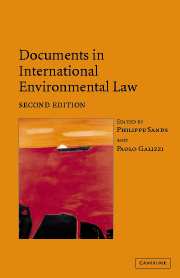Book contents
- Frontmatter
- Contents
- Preface
- PART I General instruments
- PART II Atmosphere
- PART III Oceans: global
- PART IIIB Oceans: regional
- PART IV Freshwater resources
- PART V Biodiversity
- PART VIA Hazardous substances and activities: nuclear
- PART VIB Hazardous substances and activities: pesticides
- PART VIC Hazardous substances and activities: waste
- PART VII Human rights and the environment
- PART VIII War and the environment
- PART IX Trade and the environment
- PART X Environmental impact assessment and access to information
- 38 Convention on Environmental Impact Assessment in a Transboundary Context, 25 February 1991
- 38A Protocol on Strategic Environmental Assessment, 21 May 2003
- 39 Convention on the Transboundary Effects of Industrial Accidents, 17 March 1992
- 40 World Bank Operational Policy 4.01 on Environmental Assessment, January 1999
- 41 Convention on Access to Information, Public Participation in Decision-Making and Access to Justice in Environmental Matters, 25 June 1998
- 41A Compliance Committee and Procedures for the Review of Compliance
- 41B Protocol on Pollutant Release and Transfer Registers, 21 May 2003
- PART XI Liability for environmental damage and breaches of environmental obligations
- PART XII The Antarctic
41 - Convention on Access to Information, Public Participation in Decision-Making and Access to Justice in Environmental Matters, 25 June 1998
Published online by Cambridge University Press: 05 June 2012
- Frontmatter
- Contents
- Preface
- PART I General instruments
- PART II Atmosphere
- PART III Oceans: global
- PART IIIB Oceans: regional
- PART IV Freshwater resources
- PART V Biodiversity
- PART VIA Hazardous substances and activities: nuclear
- PART VIB Hazardous substances and activities: pesticides
- PART VIC Hazardous substances and activities: waste
- PART VII Human rights and the environment
- PART VIII War and the environment
- PART IX Trade and the environment
- PART X Environmental impact assessment and access to information
- 38 Convention on Environmental Impact Assessment in a Transboundary Context, 25 February 1991
- 38A Protocol on Strategic Environmental Assessment, 21 May 2003
- 39 Convention on the Transboundary Effects of Industrial Accidents, 17 March 1992
- 40 World Bank Operational Policy 4.01 on Environmental Assessment, January 1999
- 41 Convention on Access to Information, Public Participation in Decision-Making and Access to Justice in Environmental Matters, 25 June 1998
- 41A Compliance Committee and Procedures for the Review of Compliance
- 41B Protocol on Pollutant Release and Transfer Registers, 21 May 2003
- PART XI Liability for environmental damage and breaches of environmental obligations
- PART XII The Antarctic
Summary
Editorial note
The 1998 Aarhus Convention is built on three pillars: access to information, public participation in environmental decision-making, and access to justice in environmental matters. The Convention obliges parties to ensure that public authorities make available to the public ‘environmental information’ without any interest having to be stated, generally in the form requested, and without an unreasonable charge being made (Articles 4(1) and 9). The definition of environmental information is broader than earlier instruments, making express reference, for example, to factors of biodiversity such as genetically modified organisms, and a broad range of measures (such as environmental agreements, policies, plans and programmes and cost-benefit and other economic analyses and assumptions used in environmental decision-making) (Article 2(3)). Requests are to be responded to within one month and the exceptions are to be interpreted restrictively (Article 4(2), (3) and (4)). A refusal to disclose information is to be subject to review (Articles 4(7) and 9). The Convention also imposes a positive obligation on a public authority which does not hold the information to inform the applicant where it might be applied for, and makes provision for the separation of information which would be exempted from disclosure so that the remainder may be disclosed (Article 4(5) and (6)).
Article 5 of the Convention imposes a range of positive obligations on parties, beginning with the requirement that public authorities ‘possess and update’ environmental information relevant to their functions and to establish mandatory systems to ensure adequate flow of information to public authorities about activities which may significantly affect the environment (Article 5(1)(a) and (b)).
- Type
- Chapter
- Information
- Documents in International Environmental Law , pp. 1109 - 1135Publisher: Cambridge University PressPrint publication year: 2004
- 6
- Cited by



